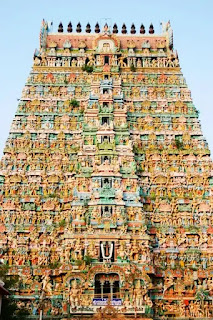 |
| Mahalaya tharpanam sankalpa. youtube.com |
 |
| Mahalaya Amavasya, Assam. .tripurastarnews.com/ |
Mahalaya Amavasya, also known as Pitru Moksha Amavasya, Pitru Amavasya or Sarvapitri Amavasya, is a traditional and most auspicious annual ritual day in the Hindu calendar dedicated to honor our ancestors - pithroos. It is an expression of thanksgiving by members to their previous generations dating back to a couple of centuries or more for all the life they have given to them. It is very much similar to All Souls Day and Christians remember and pray for “all the faithful departed”; Día de los Muertos welcomes the return of the departed for a yearly family. Many of them visit the graveyar and place flowers on the tombstone and pray for them and seek their blessings.
According to the Amavasyant calendar followed in South India, Pitru Amavasya is observed in the Bhadrapada month or Purattasi Tamil month on New Moon Day (Amavasya). For North Indians who follow the Purnimant calendar, Mahalaya Amavasya is observed in Ashwin; during September-October according to the Gregorian calendar. During this period, it is believed, that our departed ancestors - pitrus (pithroos) visit the earth to accept our shraddha offerings and bless us for our well-being. Doing mahalaya shraddha is important for the Hindus, particularly for those who have missed the Tithi on a few occasions for unknown reasons. it is good to perform sraddha every day during mahalaya paksha and if not possible, one can do it on one of the 15 days during the waning phase of the moon.
This most essential annual ritual is held in many towns on the banks of the river and will go on till Ayudha Puja Day; Hindus who prefer river banks, etc., will descend on the sites and under the guidance of Purohits/pundits pray for the salvation of the souls of their forefathers by sprinkling tharpana water mixed with black sesame seeds on the darbha grass and pindams so that they could be free from the dreadful cycles of births and deaths and pangs of joy and pains.
The benefits of Mahalaya shraddha are said to be manifold and one should perform it without fail for the benefits of progeny in his family.
Doing sraddha on prathama improves financial independence; On dvitiya, beneficial to posterity; on tritiya it promotes progress in the welfare; on chaturthi it may help us get rid of enemies; on panchami Thithi it will help us gain gold, silver, etc to be needed for wedding, etc; sapthami sraddha blesses us with power and fame ; on ashtami blesses us with knowledge; on navami doing sradha will give one gain a good life partner. If performed on dasami one’s wishes of any kind will get fulfilled; on ekadasi one gets Veda jnana; on dvadasi one’s family line continues ; on trayodashi Sharadha will get one gain decent wealth; on chaturdashi, thithi is done to appease those who had dhur maranam - unnatural death;
 |
| Mahalaya Paksha, offering pindam to pitrus, marathi.webdunia.com |
It is to ne noted that Mahalaya tharpanam , mahalaya sraddha and mahalaya Amavasya are all related to ritual offerings to ancestors and ought to be done by Hindus without fail. A simple offering in memory of pitrus will be good enough is a humble way of expressing our gratitude to them for the sacrifices they did i the past. It is a way to express our indebtedness to them without whom we won't exist on this earth.
 |
| Sarangapani kovil.templesinkumbakonam.wordpress.com |
Lots of devotees in the temple city of Kumbakonam, TN visit he famous Sarangapani temple dedicated to God Mahavishnu, who had no parent. Yet, in that temple the lord performs sraddha for a childless departed devotee. The Lord performed the funeral rites and every year he does sraddha for the devotee, as a son would for his father. Devotees who have pitru sapa visit this temple for atonement and lord's blessing to be free from the curse. We can understand the importance of sraddha From the acts of the presiding deity at the temple who takes upon himself the task of performing thithi for his ardant childless devotee we can understand how important it is for a Hindu to pay his respect his forefathers.
There are many complex and bewildering beliefs and legends related to Mahalaya Amavasya, but, the common consensus has been that sraddha will ensure moksha to ancestors - to take eternal sleep in the shadow of the lord in his heavenly abode.
Tit-bits:
Terminology:

Krishna-Shukla paksha. bhagavanbhakthi.com
Pitru = Pitru (Pitrus) are the group of our ancestors who have passed away and are staying at various other planets.
Paksha = It is the fifteen days period of the Mahalaya month.
Each of the Hindu months are divided into 15 days of two Pakshas, that is, one is Shukla Paksha and another is Krishna Paksha.
In this, the 16 days (Padya to Amavasya) are kept especially for the Pitru Paksha Mahalaya each year.
Mahalaya = This total 16 days of the Pitru Paksha is known as the Mahalaya (Maha + Alaya = Greatly + auspicious period) month for the Hindus.
https://www.thehindu.com/society/faith/mahalaya-paksha/article67360181.ece
Mahalaya Amavasya @www.smartpuja.com
https://www.smartpuja.com/blog/mahalaya-amavasya
https://bhagavanbhakthi.com/2014/02/how-to-do-pitru-paksha-tarpana-rituals-shraddha-significances/










